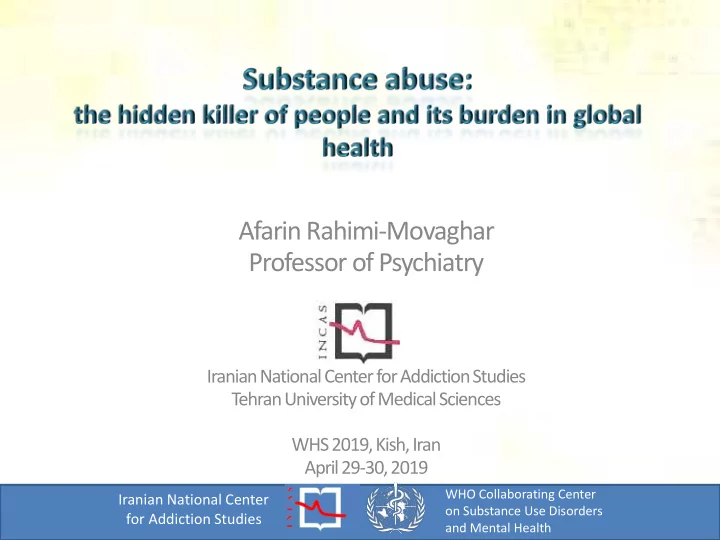

Afarin Rahimi-Movaghar Professor of Psychiatry Iranian National Center for Addiction Studies Tehran University of Medical Sciences WHS 2019, Kish, Iran April 29-30, 2019 WHO Collaborating Center Iranian National Center on Substance Use Disorders for Addiction Studies and Mental Health
11 million 30.1 million 275 million 4,900 million Alcohol users: 2000 million Tobacco: 1000 million WHO Collaborating Center Iranian National Center on Substance Use Disorders for Addiction Studies and Mental Health
Global Burden of Disease Study 2017: • 585,000 deaths • 42 million “health” years of life lost Most resulted from overdose, HCV and HIV. Over the past three decades, the number of deaths and DALYs attributed to the use of drugs have approximately doubled . WHO Collaborating Center Iranian National Center on Substance Use Disorders 3 for Addiction Studies and Mental Health
WHO Collaborating Center Iranian National Center on Substance Use Disorders 4 for Addiction Studies and Mental Health
WHO Collaborating Center Iranian National Center on Substance Use Disorders 5 for Addiction Studies and Mental Health
WHO Collaborating Center Iranian National Center on Substance Use Disorders 6 for Addiction Studies and Mental Health
Health Examples 1. Child wefare Drug user 2. Financial stability 3. Intimate partner violence Family 4. Driving under the influence of drugs 5. Crime against property and theft Community 6. Lost productivity costs 4 1 3 2 5 6 Crime Economic WHO Collaborating Center Iranian National Center on Substance Use Disorders 7 for Addiction Studies and Mental Health
WHO Collaborating Center Iranian National Center on Substance Use Disorders 8 for Addiction Studies and Mental Health
10,000 Other countries 8,000 Opium production in tons Lao PDR opium production Mexico opium 6,000 production Myanmar opium production 4,000 Afghanistan opium production Total 2,000 - 1998 2000 2002 2004 2006 2008 2010 2012 2014 2016 2018 WHO Collaborating Center Iranian National Center on Substance Use Disorders 9 for Addiction Studies and Mental Health
WHO Collaborating Center Iranian National Center on Substance Use Disorders 10 for Addiction Studies and Mental Health
WHO Collaborating Center Iranian National Center on Substance Use Disorders for Addiction Studies and Mental Health
WHO Collaborating Center Iranian National Center on Substance Use Disorders 12 for Addiction Studies and Mental Health
Opium Opium Opium Heroin Heroin Methamphetamine Methamphetamine Heroin Prescription opioids Prescription opioids Cannabis 1998 2008 2018 WHO Collaborating Center Iranian National Center on Substance Use Disorders for Addiction Studies and Mental Health
WHO Collaborating Center Iranian National Center on Substance Use Disorders for Addiction Studies and Mental Health
21.67% Drug use disorders 0.89% 0.91% 0.14% Mood and anxiety 0.08% 0.32% disorders 0.46% Alcohol use disorders WHO Collaborating Center Iranian National Center on Substance Use Disorders for Addiction Studies and Mental Health
SOURCE: Adapted from Institute of Medicine (1994, p WHO Collaborating Center Iranian National Center on Substance Use Disorders for Addiction Studies and Mental Health
WHO Collaborating Center Iranian National Center on Substance Use Disorders for Addiction Studies and Mental Health
Middle childhood Early adolescence Adolescence & adulthood Infancy & early childhood WHO Collaborating Center Iranian National Center on Substance Use Disorders for Addiction Studies and Mental Health
Infancy and early Early Early Middle childhood Adolescence Adulthood childhood adolescence adulthood (0-5 years old) (6-10 years old) (11-14 years old) (15-19 years old) (20-25 years old) (>25 years old) Prenatal & infancy visitation Parental skills Family (Selective & indicated) (Universal & selective) Personal & social skills Early childhood education Personal & social skills education education (Selective) (universal & selective) (universal & selective) Classroom management School (Universal) School policies Policies to keep children at (Universal & selective) school (Selective) Addressing individual psychological vulnerabilities (Indicated) Community-based multi-component initiatives (universal & selective) Media campaigns Community (universal & selective) Mentoring (Selective) Workplace prevention Workplace (universal, selective & indicated) Brief intervention Health sector (Indicated) WHO Collaborating Center Iranian National Center on Substance Use Disorders for Addiction Studies and Mental Health
• Long term treatment and supportive care is needed. • Use of medications , such as methadone, buprenorphine, and extended-release naltrexone, significantly improve opioid use disorder outcomes. • The effectiveness of treatment is limited by problems at all levels of the care cascade , including diagnosis, entry into treatment, and retention in treatment. • Training of health-care professionals in the treatment and prevention of drug use disorder, • Research for development of alternative medications and new models of care to expand capabilities for personalised interventions. WHO Collaborating Center Iranian National Center on Substance Use Disorders for Addiction Studies and Mental Health
• Target 3.5: Strengthening the prevention and treatment of substance abuse – Balance between prohibition with prevention and treatment – Wide access to prevention and treatment • Target 3.3: Ending epidemics of AIDS, hepatitis and tuberculosis – Harm reduction interventions – Anti-retroviral treatment for PWID with HIV/AIDS • Target 3.8: Achieving universal health coverage, access to safe, effective, quality and affordable services and essential medicines for all – Adequate amount of funds available – Integration of the services in the PHC – Pain medications available to those in need WHO Collaborating Center Iranian National Center on Substance Use Disorders for Addiction Studies and Mental Health
Available Services for drug users No. of centers No. of drug users received services All services 6341 764,500 Drug treatment centers 5263 530,091 Methadone maintenance treatment - 399,508 Buprenorphine maintenance treatment - 65,182 Outpatient detoxification - 63,375 Inpatient detoxification - 2,026 DICs 209 65,714 Outreach team 347 26,702 Shelter 42 5,946 Therapeutic Community 20 2,107 Residential drug treatment Centers 807 133,940 WHO Collaborating Center Iranian National Center on Substance Use Disorders for Addiction Studies and Mental Health
Treatment Shut down Treatment Treatment Harm reduction Over-criminalization Prevention Prevention 450 400 Research 350 Islamic revolution End of Iran-Iraq war Opium 300 production in Afghanistan 250 200 New HIV 150 cases 100 50 0 WHO Collaborating Center Iranian National Center on Substance Use Disorders for Addiction Studies and Mental Health
Recommend
More recommend